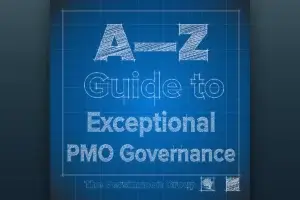Idea in Brief: AI isn’t replacing project managers—it’s exposing what they were never meant to be doing. Here’s what PMO leaders can do now to prepare their teams for the shift.
At nearly every client we work with, AI has quietly taken a seat in every meeting.
It records, transcribes, assigns actions, and produces polished summaries before anyone leaves the room. For project managers—once the keepers of notes, trackers, and schedules—it’s a strange feeling to watch a machine do, in seconds, what once filled half the week.
PMO leaders are noticing the shift, too. The work that once made a PM’s value visible is being automated out of sight. Many teams are asking the same question: If AI can handle the mechanics, what’s left for us to do?
The Comfort—and Consequences—of Being the Organizer-in-Chief
AI isn’t replacing project managers—
it’s exposing what they were never meant to be doing.
Automation hides 60–80% of traditional PM visibility signals. PMO leaders have long wrestled with the same challenge: How do I get my project managers to think beyond coordination and start leading strategically?
Coordination work offers quick wins and visible proof of progress. A clean dashboard, an on-time status report—these are easy markers of competence.
Strategic PM impact is 80% preventative, 20% reactive. Strategic work, by contrast, is a slow burn. Its success is often measured by what doesn’t happen—risks that never materialize, stakeholders who never feel blindsided, requirements that never get missed.
That work is invisible and almost always underappreciated. It’s also harder. It demands judgment, influence, and the willingness to navigate ambiguity.
Now AI is quietly chipping away at those organizing tasks—and unsettling PMs who wonder if they’ll still have a role next year.
Here’s what PMO leaders should be telling them: AI isn’t replacing project managers—it’s exposing what they were never meant to be doing.
The Work AI Can’t Touch
AI captures events, but humans
interpret the 40% unsaid context.
If you want to see the AI shift in real time, start with meeting notes. For years, they’ve been the ultimate proof of diligence—tangible evidence that the project is organized and under control.
Now, AI note-takers do the job automatically: recording every word, generating summaries before anyone leaves the room, and even tagging action items by owner.
It’s impressive. But it’s also lazy.
AI is great at capturing what happened. But project health depends on how it happened—on tone, tension, silence, and what went unsaid. AI can simulate sentiment, but it can’t feel emotion. It can’t feel the stakes of a decision, so every decision sounds the same. Every voiced agreement feels like alignment. AI captures events, but humans interpret the 40% unsaid context. AI models parse sentiment but cannot feel emotional stakes.
And here’s what else it can’t do:
- Sense when a decision was made under duress
- Flag that half the team walked away unconvinced
- Notice the hallway conversations where real opinions surface
- Read the discomfort that signals misalignment
For PMOs, that’s the hidden execution risk: when automation creates the illusion of alignment.
Researchers at Cornell tried to solve this problem. They developed Yordeai, an AI-enabled system, to assist with making informed decisions based on scattered data across multiple platforms. But there were big limitations: most notably, user isolation and inability to incorporate data beyond its reach—the hallway conversations and subtle facial expressions that hint at deeper truths.
AI can take the notes. But it still takes a human to read the room—and to lead what happens next.
From Task Managers to Sense-Makers: A New Charter for PMs
This is the evolution PMO leaders have been waiting for.
PM demand is shifting
70% toward sensemaking skills.
For years, they’ve wanted project managers who could think beyond timelines and templates—who could navigate ambiguity, anticipate friction, and translate strategy into meaningful action. Now, with AI taking on the mechanical work, that vision can finally take root. PM demand is shifting 70% toward sensemaking skills.
The most valuable project managers will be those who can:
- Interpret complex, sometimes conflicting signals from leadership
- Recognize early signs of decision friction or misalignment
- Translate context into choices teams can actually execute
- Build trust across functions when pressure is high and timelines are thin
This is sensemaking—the human skill at the heart of execution. AI can surface data, but it can’t tell a team what matters most. It can track the work, but it can’t help people move together through uncertainty.
For PMOs, the question isn’t whether AI will change the job. It already has. The real question is how leaders will guide their teams to rise to it.
AI has already redefined PM roles; leadership must redefine expectations.
For PMO leaders, this isn’t a moment to wait and see—it’s a moment to lead with intention. AI has changed what project management looks like. Now it’s up to leaders to show their teams what it means.
Here’s how we’re approaching the shift with the project managers at Persimmon:
- Acknowledge the discomfort.
Start by naming what everyone’s thinking. PMs may feel uneasy as automation takes over the visible parts of their work. Reassure them that this shift isn’t a threat—it’s a reset. - Redefine the job description.
Don’t tell PMs to “be more strategic.” Show them what that looks like. The new job is to run alignment checks before decisions harden, to translate executive intent into actionable clarity for teams, and to spot the gaps between what’s agreed and what’s understood. These are visible, high-value activities—and they’re where PMs now prove their worth. - Redefine performance.
Move beyond metrics like “on-time status reports.” Start measuring decision quality, alignment velocity, and stakeholder confidence—the outcomes that actually drive throughput. - Coach for judgment.
Use real project moments to help PMs practice reading the room, framing tough conversations, and guiding decisions under pressure. - Protect the culture.
Recording changes how people show up. Teach PMs to notice what isn’t being said on camera, to follow up privately when tension is suppressed, and to create off-record spaces where candid feedback can surface safely.
With a clear roadmap, PMO leaders can help their teams stop fearing AI—and start outperforming it.
Lead the Redefinition—or Be Defined By It
AI has already redrawn the edges of project management. The only question is who will define what comes next—technology, or leadership.
PMO leaders have a brief window to set the tone: to help their PMs see that the value of the role has never been note-taking or tracking—it’s been sensemaking all along.
Start by sharing this framework with your PMs and asking: What does sensemaking look like in our projects today?”
Those who seize that moment will build PMOs defined by clarity, not compliance; by alignment, not activity. Those who don’t may find the definition written for them, one algorithmic summary at a time.










